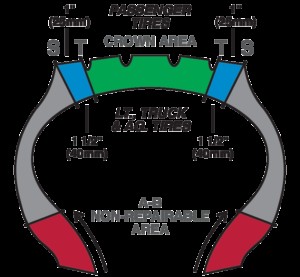Flat tires are an inevitable inconvenience for drivers. When faced with a punctured tire, the immediate reaction might be to seek a quick fix. However, understanding the nuances of tire repair is crucial for ensuring your safety and the longevity of your tires. This article, brought to you by Car Repair Online experts, delves into the proper methods of car tire repair, highlighting why temporary fixes fall short and what constitutes a safe, industry-standard repair.
The Misconception of Tire Plugs and String Repairs
Emergency plug and string repairs are often seen as convenient solutions for roadside tire punctures. They can quickly get you back on the road, seemingly resolving the issue by stopping air leaks. However, it’s critical to understand that these methods are temporary and not intended as permanent fixes. Their primary function is to provide enough support to reach a service center or your home where a proper repair can be performed.
The danger lies in the misconception that if a plug or string holds air, the tire is safely repaired. While these repairs might effectively retain air pressure, they often fail to create a complete seal of the tire injury. This incomplete seal allows moisture and air to penetrate the tire’s structure. Over time, this penetration can lead to significant internal damage, potentially resulting in a sudden and dangerous tire blowout. Ignoring a proper repair after using a plug or string is a gamble with your safety and the safety of your vehicle.
Why Patch-Only Tire Repairs Are Insufficient
Another common misconception is that applying a patch to the inner tire is a sufficient permanent repair. Similar to plug-only repairs, a patch applied alone can effectively hold air within the tire. However, the critical flaw remains: a patch by itself does not fill the puncture channel. This leaves the pathway for air and moisture to seep into the tire from the outside, through the tread, and into the tire’s internal layers. This infiltration can degrade the tire’s construction over time, compromising its integrity and increasing the risk of failure. A patch alone addresses the symptom (air leak) but not the root cause (puncture channel vulnerability).
The Industry-Recommended Proper Tire Repair Process
The only method that truly and safely repairs a punctured tire, according to industry best practices, is the patch-plug combination repair. This process not only seals the puncture from the inside with a patch but also fills the injury channel with a plug, creating a comprehensive and robust seal. To help remember the steps involved in a proper tire repair, we use the acronym R.E.P.A.I.R.
-
Remove: The first crucial step is to remove the tire from the wheel. This is essential for a thorough inspection of both the interior and exterior of the tire. A proper repair cannot be performed with the tire still mounted on the wheel.
-
Evaluate: Once removed, the tire needs to be carefully evaluated. This involves examining the puncture to determine its size, direction, and angle. It’s also critical to assess if the puncture has caused any damage to the tire’s internal structure, such as the steel belts or fabric cords.
-
Prepare: If the evaluation determines that the tire is repairable, the next step is preparation. This involves preparing both the injury channel and the inner liner for the repair materials to adhere correctly. The injury channel is drilled out using a carbide cutter to remove any damaged cords, debris, and to create a clean path for the plug portion of the repair. The inner liner around the puncture area is then cleaned and buffed to create a slightly rough surface, which is crucial for optimal adhesion of the patch.
-
Apply: Next, vulcanizing fluid is applied to both the prepared injury channel and the buffed area on the inner liner. This fluid acts as a chemical adhesive, helping the repair unit bond effectively with the tire rubber. The vulcanizing fluid needs to air dry for approximately 5-10 minutes to become tacky before proceeding to the next step.
-
Install: The combined patch-plug repair unit is then installed. The plug portion is inserted through the injury channel from the inside of the tire, and the patch portion is carefully applied to the prepared inner liner. Using a tire stitcher, the patch is thoroughly stitched down, working from the center outwards to eliminate any trapped air bubbles and ensure a solid bond. After installation, any excess repair material extending beyond the tread surface is trimmed, typically to about ¼ inch.
-
Return to Service: Finally, the repaired tire is ready to return to service. This involves remounting the tire onto the wheel, inflating it to the correct pressure, balancing the wheel and tire assembly, and then remounting it onto the vehicle. After a proper R.E.P.A.I.R. procedure, the tire should be safe and ready for regular use.
 the repairable are of most tires is restricted to the crown
the repairable are of most tires is restricted to the crown
Determining Tire Repair Safety: Key Factors
Not every punctured tire is suitable for repair. Several factors determine whether a tire can be safely repaired. These factors primarily fall into three categories:
-
Location of the Puncture: For standard passenger car tires, repairs are only considered safe if the puncture is located within the crown area of the tire. The crown is the central tread area. Damage to the tire’s shoulder (the area between the crown and sidewall) or sidewall itself is generally considered non-repairable due to the high degree of flexing and stress in these areas.
-
Puncture Size Limit: There are limitations on the size of the puncture that can be safely repaired. For passenger and light truck tires with fabric plies, the maximum repairable puncture size is typically ¼ inch (6mm). For steel-belted light truck, medium, and heavy-duty truck tires, a slightly larger puncture size of up to 3/8 inch (10mm) may be repairable. Punctures exceeding these sizes often indicate more significant internal damage.
-
Overall Tire Condition: The overall condition of the tire is a critical factor. Tires with excessive wear, showing signs of casing separation, or having sustained impact damage or other forms of deterioration may be deemed unsafe to repair. Repairing a tire that is already compromised in other ways can lead to premature failure and safety risks. For a more detailed guide on assess tire condition for repair suitability, you can consult resources like “Can Your Tire Be Repaired?”.
Conclusion: Prioritizing Proper Tire Repair for Safety
Dealing with flat or slow-leaking tires is an unavoidable part of vehicle ownership. While temporary fixes like plugs and strings offer immediate convenience, they should never be considered permanent repairs. Similarly, patch-only repairs are also insufficient for long-term tire safety. To ensure your safety and the safety of your passengers, it is vital to prioritize proper tire repair methods, specifically the patch-plug combination. Taking the time to understand the correct repair process and seeking out qualified tire service professionals is an investment in your vehicle’s reliability and your personal safety on the road. When in doubt, always consult with a reputable tire repair shop to ensure the job is done right.

